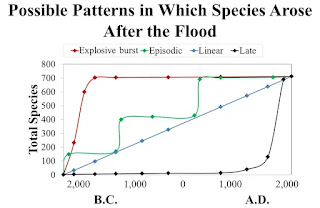"Today, many biological families contain numerous species, implying that new species have arisen since the Flood.
*Since Scripture never forbids speciation, nothing in the Bible suggests that the formation of new species within a kind is impossible.
*Thus, speciation within kinds is perfectly compatible with Genesis and with the rest of Scripture.
Theoretically, these species could have originated in a variety of temporal patterns. For example,
Theoretically, these species could have originated in a variety of temporal patterns. For example,
---they could have formed in an explosive temporal burstimmediately following the Flood. If so, this might suggest post-Flood conditions as a catalyst of speciation. Alternatively,
---speciation might have occurred in fits and spurts, perhaps in a manner correlated with human migrations and conquests. If so, speciation might have a relationship to human activity.
Based on genetic comparisons between species, the pattern that emerges is fairly linear. In other words, species have been forming in families at approximately constant rates since the Flood.
For example, 55 species in the deer family are living today. Among the species with readily available genetic information, genetic comparisons show a linear pattern of speciation. On the basis of this result, a new deer species appears to have formed approximately every 80 years.
First, it implies that species are still forming. For example, in felids, since one new cat species has arisen approximately every 120 years, we can expect to see another felid species form in the next 120 years. In fact, in the most species-rich kinds, we can expect new species to form in our lifetimes. For those who are accustomed to thinking in evolutionary terms, this fact will come as a shock.
Second, today’s species have a direct line of descent back to the Ark. This should be obvious from what we already said, but it’s a point worth repeating. Today’s species are the link between the past and the present. The genetics of the species around us today contain the echo of the Ark.
Third, speciation rates are declining on a per species level. Since the rate of speciation is constant within a family, but since the number of species within a family is increasing, speciation rates per species are declining."
AIG




.jpg)